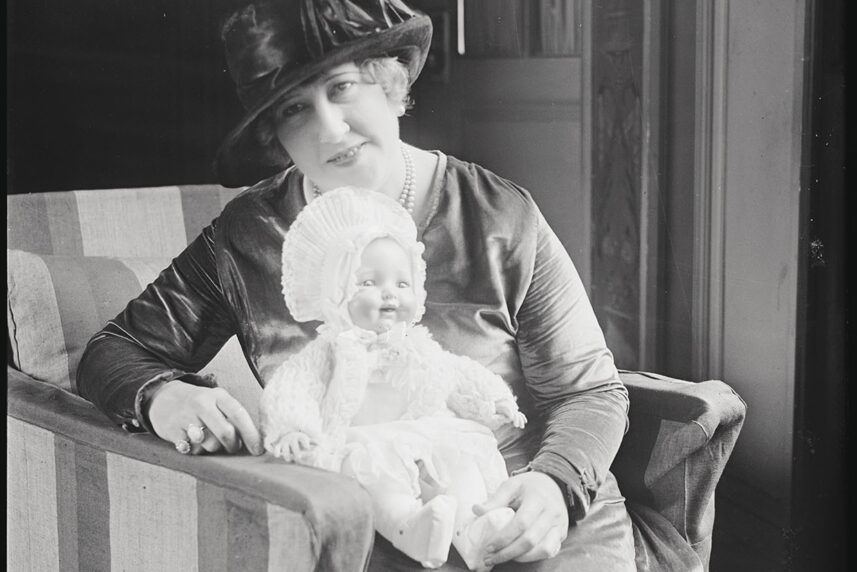Article:
Ingenuity led to success for Raleigh native,
aka “Lady Edison”
BY MARILYN JONES
Everyone knows what a hair curler is, that some doll eyes open and close, and that sewing machines can make a double stitch. But did you know a Raleigh native named Beulah Louise Henry invented these products and processes? Furthermore, she created more than 100 valuable household and office items—and held 49 patents.
Born in Raleigh in 1887 to an artistic family, this professional inventor began tinkering with objects as a child in an effort to create more practical objects. Her favorite hobby was pointing out how to improve innovations. Henry’s father, a lawyer, was also an authority on art. Her mother was an artist and homemaker.
Henry studied at Presbyterian College for Women and Elizabeth College in Charlotte from 1909 to 1912. She didn’t have an engineering education, which made her more creative when it came to solutions. Her focus often involved inventions that improved the quality of life for women. By the 1930s, Henry had earned the nickname “Lady Edison” and achieved fame as an inventor in a male-dominated profession.
An Impressive Start
Henry never married or had children, but descended from a notable lineage. She was the granddaughter of former North Carolina Governor William Woods Holden and a direct descendant of President Benjamin Harrison on her mother’s side, and of founding father Patrick Henry on her father’s side.
In 1912, while in her mid-20s, Henry applied for a patent for a vacuum ice cream freezer—a device that could make ice cream that didn’t require cranking like previous manual ice cream makers. Two other patents followed in 1913: one for a handbag and the other for an umbrella featuring a snap-on cloth cover that allowed the owner to coordinate the umbrella with his or her clothing.
Henry moved to New York City in 1919 with her parents, who felt their daughter would have a better chance to sell her umbrella and other ideas in the big city. But convincing manufacturers to make the umbrella was challenging. They said it couldn’t be done, so she made her own prototype and eventually opened the Henry Umbrella and Parasol Company. She found a large market for her umbrellas in New York, and was later featured in Scientific American as an “outstanding inventor.” She went on to establish the B.L. Henry Company of New York.
Historians believe Henry might have had mild synesthesia, a condition in which the mind assigns sensory attributes to other senses—associating colors with sounds, for example. This condition is common in artistic people and undoubtedly assisted Henry in creating her inventions.
Patently Successful
In 1924, Henry sold the rights to her umbrella cover invention for $50,000 (approximately $630,000 in today’s dollars). This enabled her to set up her laboratory. She hired mechanics, model makers and drafting technicians to turn her ideas into prototypes. Other successful inventions soon followed and, before long, Henry gained a reputation as one of the most prolific inventors of her era. Throughout the 1920s, she went on to receive patents for a spring-limbed doll, a valve for inflatable articles and Dolly Dips—sponges that held soap in the middle. (She also designed the machine that produced the sponges.)
Henry eventually turned her attention toward machines and, during the 1930s and 1940s, made many improvements to sewing machines and typewriters. Her patents during this time included a feeding and aligning device for typewriters, a bobbin-less sewing machine, several children’s toys, and another typewriter attachment for duplicating documents. She also invented continuously attached envelopes for mass mailings, a can opener, and the direct and return mailing envelope.
Henry worked for Nicholas Machine Works as an inventor from 1939 to 1955. She also consulted for Mergenthaler Linotype Company and the International Doll Company. At the time she registered her patents, only 2% of patents were written by women, making Henry truly impressive in her field. She is still considered one of the most successful female inventors of all time.
Henry also enjoyed writing, painting and caring for animals. She was active in the National Audubon Society, League for Animals and other institutions. She passed away in 1973 at the age of 85 and was posthumously inducted into the National Inventors Hall of Fame in 2006.
According to the U.S. Patent and Trademark Office, Henry’s “technologies were complex and ingenious, yet easy to manufacture and use. Her typewriters, toys, sewing machines and women’s apparel made Henry a famous and beloved figure nationwide.” Her legacy lives on in the many inventions and improvements to existing products she made throughout her lifetime.
Sources: Library of Congress, TheFamousPeople.com, The Global Innovation Center, and the Engineering and Technology History Wiki



